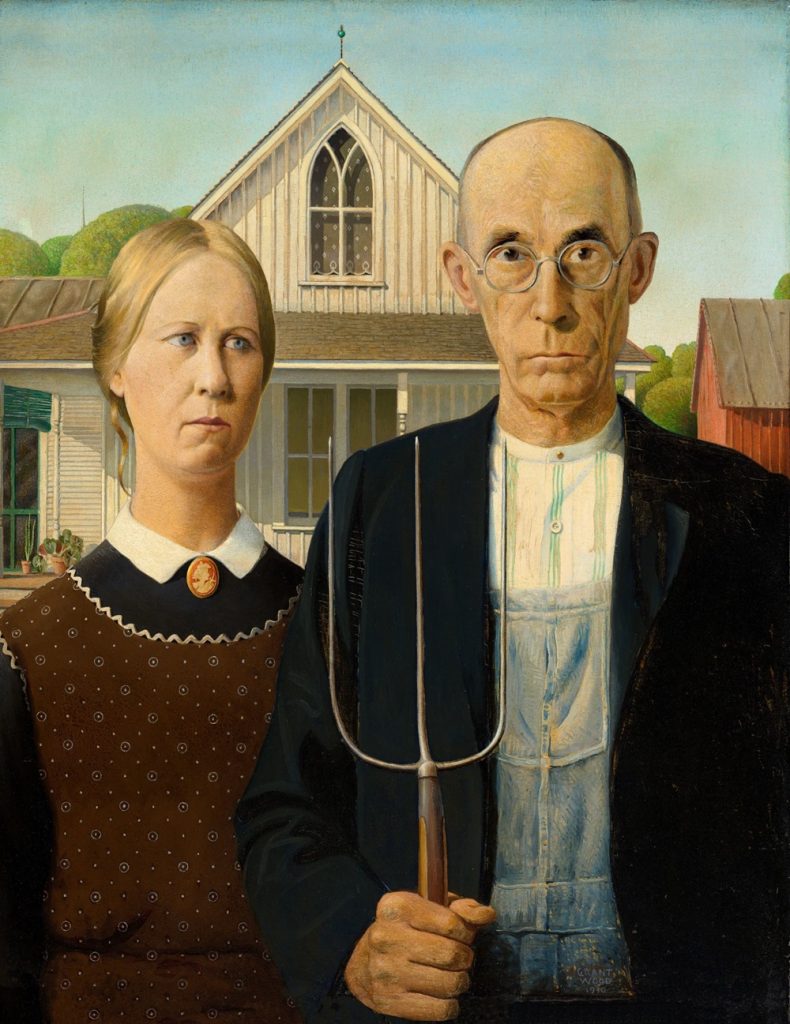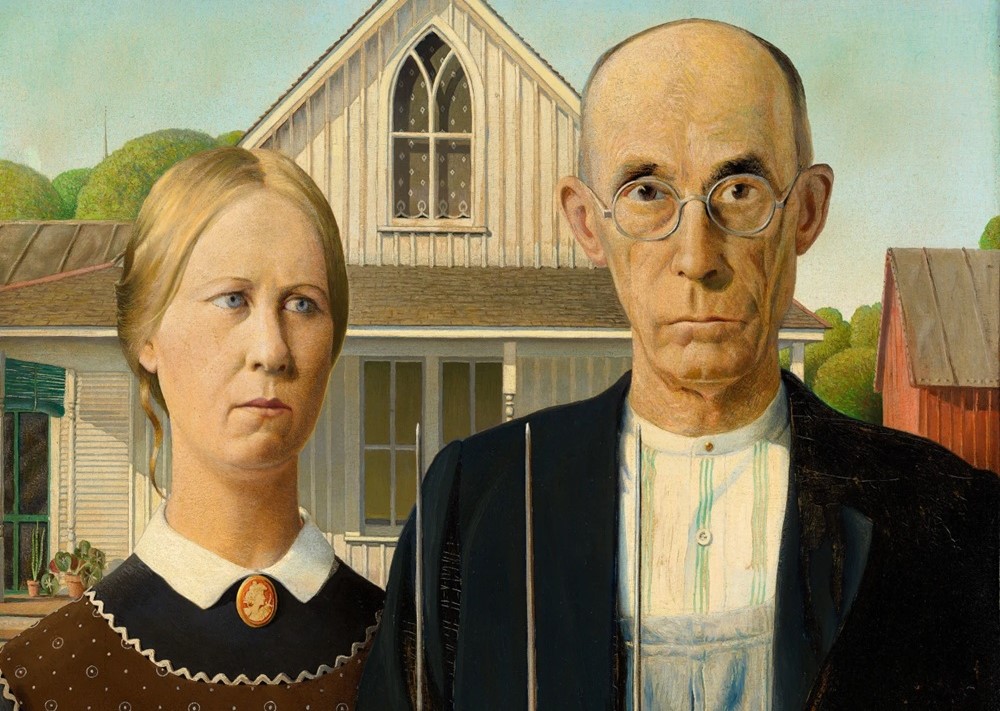The technique does not constitute art. Nor is it a vague, fuzzy romantic quality known as ‘beauty,’ remote from the realities of everyday life. The depth and intensity of an artist’s experience are essential in art.
– Grant Wood
Grant Wood is significant in American art and the American Regionalist movement that started in the 1930s. Wood, born in 1891, incorporated regionalism, concentrating on capturing rural life and landscapes to celebrate the distinctive qualities of the various American regions. Wood contributed to the rise of regionalism as a well-known art trend, along with artists like Thomas Hart Benton and John Steuart Curry. Wood’s most notable piece of art is “American Gothic,” an iconic American picture that has permeated popular culture. Standing in front of a farmhouse are a grim-faced farmer and his daughter, who have come to symbolise American tenacity during the Great Depression. The artwork impacts literature, film, advertising, and other artistic mediums.
The Wood deeply regarded American identity and culture with his frequent depictions of the Midwest and its people. His paintings captured the essence of rural life while showcasing the bravery and dignity of ordinary Americans. Wood was well known for his meticulous attention to detail and fine craftsmanship. He regularly used precise techniques, and his works’ composition, colour, and form were skillfully done. His dedication to quality control also increased his artwork’s longevity and timeless appeal.
Wood has influenced later generations of American artists. Numerous artists who have tried to use their art to explore and express their cultural identities have been influenced by his commitment to portraying American life and his distinctive style. Beyond mere representation, Wood’s imaginative vision aimed to capture the spirit and individuality of the American people. His paintings often evoked nostalgia and a romanticised view of country life, which led to a broader cultural understanding of American identity. He aided in the development of artistic movements and the advancement of American art. His impact extended beyond his works to encompass the promotion and development of the arts.
American Gothic: Cultural Commentary
American painter Grant Wood is famous for his 1930 “American Gothic.” A classic example of regionalism, “American Gothic” highlights Wood’s dedication to encapsulating the spirit of American life, especially in the Midwest. A farmer and his daughter are shown in the painting in front of a farmhouse designed in the Gothic Revival style. Their severe facial expressions represent the American people’s resiliency and grit in economic adversity.
Many people read “American Gothic” as a critique of American identity, morals, and rural communities’ difficulties during the Great Depression. The picture sheds light on the challenges faced by the American working class by reflecting the social and economic context of the day. The pitchfork and the Gothic Revival-style home, the composition’s two main focal points, have had their metaphorical meanings examined. According to particular views, the pitchfork stands for laborious work and the agricultural lifestyle. Some, however, interpret it as representing the farmer’s resistance to hardship.

Wood’s work is also renowned for its nuanced satire and humour; even though it could seem like an austere portrayal of country life, the severe emotions on the subjects’ faces and the peculiar relationship between the farmer and his daughter give the piece a nuanced and satirical quality. One of the most well-known and most parodied images in American art is “American Gothic.” Its significance has been enhanced by its ongoing popularity, which continues to draw attention from the public and serve as a symbol of American culture.
Celebration and Critique of American Identity
Many people view “American Gothic” as celebrating American identity, mainly rural life’s laborious and stoic nature. However, some readings point to a nuanced criticism, casting doubt on the romanticised portrayal of the American farmer during the difficult Great Depression era of the country’s history. The solemn expressions on the subjects’ faces can suggest a spirit of grit and tenacity in the face of difficulty.
A fundamental component of the piece, the farmer’s pitchfork, has been interpreted in several ways. Some say it represents labour, hard effort, and rural life. Some speculate that it might mean the farmer’s resistance or defiance, reflecting the difficulties rural communities endured during the Great Depression. Wood added humour and irony to the picture, even though it seemed to be a simple portrayal. Some have seen the piece as a sarcastic satire on the conservative beliefs associated with rural America because of the stern expressions of the characters and the strange pairing of the farmer and his daughter.
One could interpret “American Gothic” as a social commentary that reflects the artist’s perceptions of American culture. Wood was well-known for his fascination with portraying people’s everyday lives, and the social and economic climate of the day is reflected in this painting. The artwork honours the classic American portrait, especially the American Regionalist painters of the 19th century. Wood combined modernity and history by adapting the farmhouse’s Gothic Revival building and incorporating it into a contemporary context.
Conclusion
Grant Wood’s classic painting “American Gothic,” which was created in 1930, captures the spirit of rural life during the Great Depression and symbolises American art and culture. A humble Gothic Revival house serves as the background for the painting’s remarkable picture of a stern farmer and his daughter, who is sometimes mistaken for his wife. The image speaks to themes of endurance, tradition, and the complexity of the American character.
The severe emotions of the subjects and Wood’s meticulous attention to detail combine to produce a potent commentary on the socioeconomic circumstances of the time. Pitchforks symbolise labour-intensive tasks, and the characters’ intense looks convey a stoic will to bear trials. Meanwhile, the farmhouse’s Gothic window connects the past and present by evoking a sense of historical continuity and cultural identity.
“American Gothic” has always been appealing because of its ambiguity and the range of interpretations it might elicit. Some see it as a criticism of rural America’s conservative and exclusive character. Conversely, some consider it an homage to the American farmer’s grit and tenacity. The more considerable intricacies and paradoxes present in American life are mirrored in this dualism.






